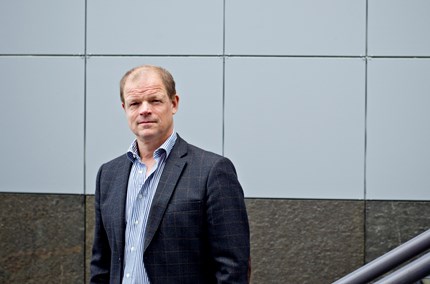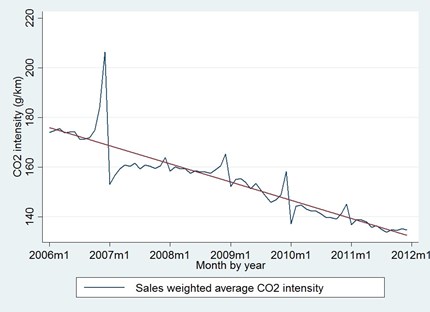Norway’s registration tax is a major tax on the sale of new cars, which is intended to reduce the carbon intensity of cars.
Professor Gunnar S. Eskeland

Through its registration tax, Norway has taken drastic steps to transition to cars with low carbon emissions. This has resulted in a significantly cleaner stock of new vehicles.

After the one-off registration tax was introduced in 2007, the carbon emission intensity of new car sales in Norway has drastically decreased. While the average in 2006 was 178 grams carbon per kilometre, the figure had decreased to 134 grams in 2011.
New research from NHH shows that around 80 per cent of this reduction is due to the introduction of the registration tax.
In short, the one-off registration tax is a fee on new car purchases that takes the form of what is known as a ‘feebate’. This means that it functions as a subsidy if the car’s carbon emission intensity is lower than 95 grams carbon/km, and as a fee if emissions exceed this level.
Norway’s registration tax is a major tax on the sale of new cars, which is intended to reduce the carbon intensity of cars.
Professor Gunnar S. Eskeland
The fee is also progressive: The amount increases in line with carbon intensity.
‘Norway’s registration tax is a major tax on the sale of new cars, often amounting to 100 or 200 per cent of the car’s production price, which is intended to reduce the carbon intensity of cars,’ says Gunnar Eskeland, professor of environmental economics at NHH. He is behind the study along with PhD research fellow Shiyu Yan.
Since its introduction in 2007, the registration tax has increased dramatically, with a regular increase on 1 January each year. The results of the study show two particularly interesting patterns, according to Eskeland.
He calls them ‘homo economicus 1 and 2’, from the concept in the field of economics that characterises consumers as entirely rational and utility-maximising.
Homo economicus 1 refers to the rapid decrease in carbon intensity in new car sales in line with the increased cost of carbon emissions. The carbon content of new car sales is on its way down in all European countries, but more so in Norway than the rest of Europe, particularly after 2007.
Homo economicus 2 refers to the jumps seen in the graph when following the line downwards. The jumps occur in November and December because many Norwegians buy heavy and carbon intensive cars in these two months just before the registration tax is increased (graph).

He believes that these ‘spikes’ on the graph show that the tax works. Researchers have used an econometric model to estimate the effects and discovered that 80 per cent of the reduction is due to the registration tax.
‘The remaining 20 per cent is due to factors such as changes in income, preferences and improvements in technology.’
Researchers have also quantified how changes in car prices through increased taxes affect the carbon emission intensity. They have discovered what is known as carbon elasticity on car prices of -0.5.
‘The response to this instrument is that if we adjust the carbon tax to such an extent that the average price of a new car is 10 per cent more expensive, the average car will have 5 per cent lower carbon emissions. It is not the cars that are changing, but the consumers’ choices,’ states Eskeland.
In the study, the researchers have also divided the cars into segments according to their size and area of use. When you buy a new car, the reduction of carbon intensity can namely take place in two ways – either by consumers buying a car from a segment with smaller and lighter cars or by buying cleaner cars from within the same segment. Carbon emissions per kilometre, for example, can be reduced by switching from a SUV to an estate car. Alternatively, you can buy a smaller and lighter SUV than you originally had.
It was unfortunate that politicians suddenly focused exclusively on carbon and I said that this was not a wise move when the carbon tax was introduced.
Professor Gunnar S. Eskeland
The study finds that cars in the bigger and heavier segments are losing sales and are becoming more carbon-efficient as a result of the registration tax. The cars in the middle segment are also becoming more carbon-efficient, but are not losing sales. The most efficient cars, such as small cars and electric cars are not becoming particularly more carbon-efficient, but the sales of these cars is increasing.
‘Many people have thought that the Norwegian carbon tax first and foremost works by adjusting the composition of different cars in the segments. However, our model actually indicates that the contribution made by making each segment more carbon-efficient and people switching to more carbon-efficient car segments is actually quite similar,’ says Eskeland.
In addition to this, the registration tax has made a historical contribution to shifting the market's attention in the direction of diesel cars. A car that runs on diesel emits less carbon per kilometre and this has contributed to increasing the percentage of diesel cars from 48 per cent in 2006 to 76 per cent in 2011.
‘The carbon tax will necessarily favour diesel ahead of petrol. Now, however, many new instruments have been implemented in Norway that are intended to take a tougher line on diesel in the more polluted cities. It was unfortunate that politicians suddenly focused exclusively on carbon and I said that this was not a wise move when the carbon tax was introduced,’ says Eskeland.
‘It’s unfortunate both because air quality was forgotten and because environmental policy strategies have to be well-considered and depend on respect.’
The uproar surrounding the diesel prohibition as a response to Oslo’s air pollution can raise questions as to whether this favouritism is expedient. However, Eskeland believes that the sum of these and other instruments is not the worst solution imaginable.
‘Polluted cities should have an environmental policy that is different to the rest of the country. So if diesel is a useful energy source for the transport sector, it’s positive that there are fewer diesel cars in polluted cities and relatively more in rural areas.’
‘In the same way, clean electric cars can better serve cities that have problems with air pollution than beautiful island communities.’
That cars are becoming more and more energy efficient as a result of the one-off registration tax is not only positive. A more fuel-efficient car reduces namely the cost of using it and we could end up with what is known as the ‘rebound effect’.
This entails an increase in car use as a result of higher fuel efficiency, or electrification, precisely because the cars have become cheaper to use.
‘We also need to consider what should influence car use. Driving a car mustn't become too cheap as a result of user costs being pulled down by the registration tax. We can use supplementary instruments, such as toll rings to restrict car use in the cities.’
Eskeland believes that lack of space in cities gives grounds for pricing road use. This also entails that electric cars have to pay their way. However, making it more expensive to drive a car in rural areas is not a straightforward solution since it may hurt more than it costs.
‘Public transport is an alternative in cities that is not available to rural communities. This means that we can tighten the grip more in cities than in rural areas,’ says the professor.
Norway is a small and rich country, so it could be seen as positive that we are doing something that costs a lot and that the rest of the world is able to learn from it.
Professor Gunnar S. Eskeland
There is no escaping the fact that the instrument is expensive. Eskeland believes that the emission reductions cost on average about NOK 3,000 to 10,000 per tonne of carbon, which corresponds to a hundred times the quota price in Europe and ten times as much as carbon’s estimated climate cost.
However, he adds a more optimistic view of the high costs.
‘Norway is a small and rich country, so it could be seen as positive that we are doing something that costs a lot and that the rest of the world is able to learn from it. We may also contribute to stimulating a technological development. Seen in isolation, however, it is actually very expensive,’ concludes Gunnar Eskeland.